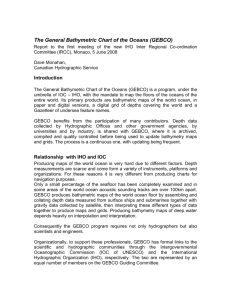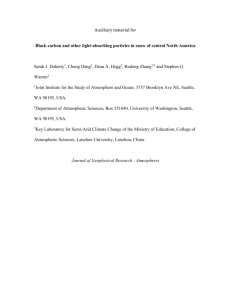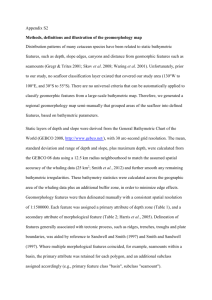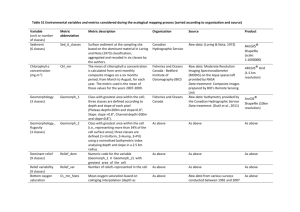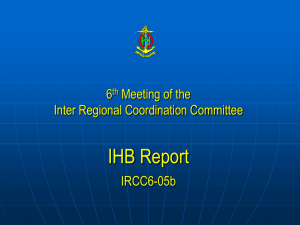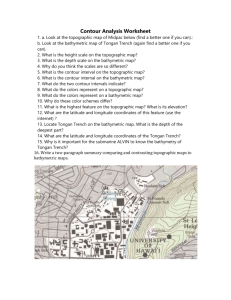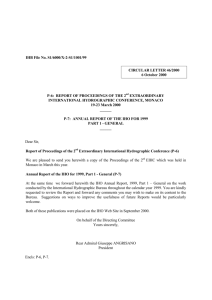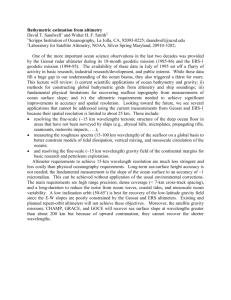INFORMATION DOCUMENT
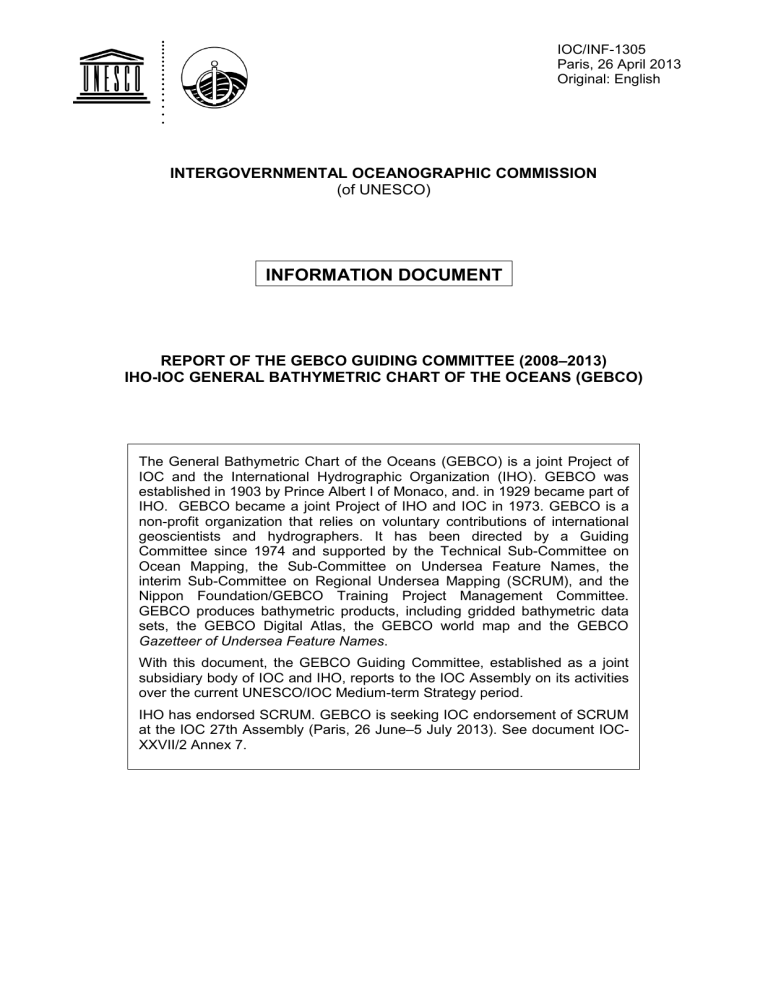
IOC/INF-1305
Paris, 26 April 2013
Original: English
INTERGOVERNMENTAL OCEANOGRAPHIC COMMISSION
(of UNESCO)
INFORMATION DOCUMENT
REPORT OF THE GEBCO GUIDING COMMITTEE (2008 –2013)
IHO-IOC GENERAL BATHYMETRIC CHART OF THE OCEANS (GEBCO)
The General Bathymetric Chart of the Oceans (GEBCO) is a joint Project of
IOC and the International Hydrographic Organization (IHO). GEBCO was established in 1903 by Prince Albert I of Monaco, and. in 1929 became part of
IHO. GEBCO became a joint Project of IHO and IOC in 1973. GEBCO is a non-profit organization that relies on voluntary contributions of international geoscientists and hydrographers. It has been directed by a Guiding
Committee since 1974 and supported by the Technical Sub-Committee on
Ocean Mapping, the Sub-Committee on Undersea Feature Names, the interim Sub-Committee on Regional Undersea Mapping (SCRUM), and the
Nippon Foundation/GEBCO Training Project Management Committee.
GEBCO produces bathymetric products, including gridded bathymetric data sets, the GEBCO Digital Atlas, the GEBCO world map and the GEBCO
Gazetteer of Undersea Feature Names .
With this document, the GEBCO Guiding Committee, established as a joint subsidiary body of IOC and IHO, reports to the IOC Assembly on its activities over the current UNESCO/IOC Medium-term Strategy period.
IHO has endorsed SCRUM. GEBCO is seeking IOC endorsement of SCRUM at the IOC 27th Assembly (Paris, 26 June –5 July 2013). See document IOC-
XXVII/2 Annex 7.
IOC/INF1305
GEBCO Report to the Intergovernmental Oceanographic Commission
The General Bathymetric Chart of the Oceans is a joint Project of IOC and the International
Hydrographic Organization (IHO). GEBCO was established in 1903 when Prince Albert I of
Monaco offered t o organize and finance the production of a new chart series designated: “The
General Bathymetric Chart of the Oceans” (GEBCO). In 1922 the responsibility for GEBCO was passed to the Director of the Oceanographic Museum of Monaco and in 1929 it was transferred to the International Hydrographic Bureau (today the IHO). GEBCO became a joint Project of the IHO and the IOC in 1973.
The key goals of GEBCO are to:
Make available and improve the authoritative description of global ocean depths;
Act as the designated international authority for undersea feature names;
Important additional roles are:
Promoting education and training in ocean mapping;
Developing ocean mapping products for science, education and general outreach
Encouraging and assisting local and regional ocean mapping efforts;
Enhancing the exchange and preservation of bathymetric data;
Encouraging the mapping of areas that are insufficiently surveyed;
Advancing the development and application of sea floor mapping technology.
GEBCO is not constituted nor funded to carry out bathymetric surveys.
Organization
GEBCO is a non-profit organization that relies largely on the voluntary contributions of an international team of geoscientists and hydrographers who work on the development of a range of global bathymetric data sets and data products. GEBCO's work is directed by a Guiding
Committee and supported by the Technical Sub-Committee on Ocean Mapping (TSCOM), the
Sub-Committee on Undersea Feature Names (SCUFN), the interim Sub-Committee on Regional
Undersea Mapping (iSCRUM), and the Nippon Foundation/GEBCO Training Project Management
Committee. Additional ad hoc working groups are convened as necessary. Through the work of its committees and working groups, GEBCO produces and makes available a range of bathymetric data sets and products, including gridded bathymetric data sets, the GEBCO Digital Atlas, the
GEBCO world map and the GEBCO Gazetteer of Undersea Feature Names. GEBCO maintains a comprehensive website at http://www.gebco.net
.
Current GEBCO Officers
Chair, GEBCO: Dr Robin K. H. Falconer (IOC appointed)
Vice-Chair, GEBCO: Dr Christopher G. Fox (IHO appointed)
Permanent Secretary/Treasurer, GEBCO: Mr David M. Clark
Chair, Technical Sub-Committee on Ocean Mapping (TSCOM): Dr Walter H.F. Smith
Chair, Sub-Committee on Undersea Feature Names (SCUFN): Dr-Ing. Hans-Werner Schenke
Chair, interim Sub-Committee on Regional Undersea Mapping: Dr Martin Jakobsson
Director, IHO Data Centre for Digital Bathymetry: Ms Lisa A. Taylor
GEBCO Bathymetric Editor: Vacant
IOCINF-1305 – page 2
GEBCO Digital Atlas Manager: Ms Pauline Weatherall
Full information on current membership can be found on the GEBCO website.
GEBCO Products and Projects
Bathymetric grids
GEBCO’s latest bathymetric product is a global terrain model at 30 arc-second intervals. The bathymetric portion of the GEBCO Grid is largely based on a database of ship-track soundings with interpolation between soundings guided by satellite-derived gravity data, where they improve on the existing grid; data sets developed by other methods have also been included.
It is intended to continually update the grid as new data sets become available. In order to do this, regional expertise is required. Through SCRUM, GEBCO is aiming to build on and extend its collaboration with regional mapping groups in order to improve its bathymetric models.
The GEBCO Grid was originally released in January 2009, with updated versions made available in November 2009 and November 2010. Details on the updates included in these releases can be found on the web site: http://www.gebco.net/data_and_products/gridded_bathymetry_data/gebco_08_update_history/
A new release of the GEBCO Grid is planned for late Spring 2013 and it is expected to include the following updates:
IBCAO V3 ( www.ibcao.org
)
IBCSO V1 ( www.ibcso.org
)
Data fr om Geoscience Australia’s Australian Bathymetry and Topography Grid, June
2009’ ( www.ga.gov.au/meta/ANZCW0703013116.html
)
Data from Olex ( http://www.olex.no/index_e.html
) primarily for shallow water regions off West Africa and the North Atlantic-Arctic shelves
Shallow water data supplied by the East Asia Hydrographic Commission for part of the South China Sea region
A grid based on multibeam data from a number of cruises for the Gulf of Cadiz region, west of the Strait of Gibraltar (doi:10.1016/j.epsl.2008.12.005)
Data from the Lamont-Doherty Earth Observatory (LDEO) Global Multi-Resolution
Topography (GMRT) data set ( http://www.marine-geo.org/portals/gmrt/ )
The GEBCO Grid is accompanied by a Source Identifier (SID) Grid. This data set shows which of the corresponding cells in the GEBCO Grid are based on soundings or existing grids and which have been interpolated.
GEBCO’s grids can be downloaded from the internet; details are given on GEBCO’s web site: http://www.gebco.net/data_and_products/gridded_bathymetry_data/ .
Standardization of Undersea Feature Names
The main task of the IHO-IOC GEBCO Sub-Committee on Undersea Feature Names (SCUFN) is to evaluate and select names for undersea features, on the principles contained in the IHO
Publication B-6 Standardization of Undersea Feature Names . Proposals for undersea feature names can be submitted to GEBCO or its parent organizations, IHO and IOC, by national and international authorities, individuals and scientific organizations.
Based on the accepted undersea feature names, SCUFN compiles and maintains, as major product, the global GEBCO-
IOCI/INF-1305
– Page 3
Gazetteer of Undersea Feature Names (IHO Publication B-8). As of 2012, the IHO-IOC Publication
B-6 is published in six separate translations from the English version (Chinese, French, Japanese,
Korean, Russian, and Spanish).
The Gazetteer contains a global data base of Undersea Feature Names maintained by SCUFN and managed by IHO. It is currently made available in spreadsheet or PDF form. A development effort is underway by the IHO Data Center for Digital Bathymetry to provide a web service and an on-line interface to a new geospatially enabled Gazetteer database. This will include the ability to search and download the Gazetteer information via text and interactive map as shape files, spreadsheet, text and PDF. Additional functionalities will be available to the SCUFN secretary to manage the database at IHO. The new interface and web service will be accessible from the
GEBCO web site by the summer of 2013.
Further work of SCUFN reflects the use of undersea feature names in Geographic Information
Systems (GIS) and in the GEBCO Digital Atlas (GDA). With the view of progress in ocean survey technology and scientific interpretation, it was decided to establish a Working Group tasked to examine the Terminology Section of the Publication B-6, in particular to discuss the content of the list of generic terms. Another Working Group was established to rebuild the GEBCO Gazetteer into a geospatially enabled database. The main function is to re-define the geographic extent of the undersea features in order to enhance display and search options in various products like Webbased mapping and GIS. The Working Group on updating the GEBCO Gazetteer into a geospatially enabled relational database, in cooperation with the US National Geophysical Data
Center, the British Oceanographic Data Centre, and Germany's Alfred Wegener Institute, is in the process of defining the topology of all undersea features of the GEBCO Gazetteer , based on general geometric primitives (point, line, and polygon). The determination of the geographic extent of all features is an ongoing process.
Since 2008, SCUFN has considered 408 undersea feature names and has accepted 223. The
GEBCO Gazetteer now includes almost 4000 undersea feature names: http://www.gebco.net/data_and_products/undersea_feature_names/
GEBCO World Map
A wall poster size world map was produced in 2008 based on the GEBCO 1-min grid. With the support of the Nippon Foundation, the Margaret Blodgett Foundation and Stockholm University,
5000 copies were printed and all were distributed. The World map has now been updated using the new GEBCO_08 grid as the main bathymetric source. The map is available for download from the GEBCO web site: http://www.gebco.net/data_and_products/gebco_world_map/ . Printing is planned to take place by setting up several print shops in different countries in order to avoid the large cost of shipping maps across the World. A version with undersea feature names from the
GEBCO SCUFN Gazetteer is in preparation.
Capacity Building
At the 100 th
year celebrations of GEBCO in 2003, it was acknowledged that most of those active in ocean mapping were of an older generation. Since then, with funding from the Nippon Foundation of Japan, GEBCO has trained a new generation through a special GEBCO designed and managed course in ocean mapping at the University of New Hampshire (UNH). There are now 46 course graduates working back in their home country organizations, two in international industry and six currently at UNH. A new group begins in August 2013. Scholars are from 28 countries bounding on all the world’s oceans. Existing scholars are active members on GEBCO subcommittees and working groups and increasingly are in influential positions in their national organizations and internationally as a result of their training.
The UNH GEBCO course is a one-year Master level course. Students are taught theoretical and practical aspects of ocean mapping, work on a team project, spend time at other ocean mapping
IOCINF-1305 – page 4 institutes and participate in a deep sea mapping cruise. The Nippon Foundation funding for the
UNH programme, of about US$ 540,000 per year, pays all tuition and expenses for the students and a modest stipend.
The Nippon Foundation granted GEBCO, in 2010, a sum of US$ 400,000 to establish a programme of further development of the existing scholars and deepening of the ocean mapping human network. This is being largely carried out through development of regional mapping programmes involving the scholars, specialist short courses on new ocean mapping developments and support for international collaboration initiatives.
Opportunities and issues:
The Nippon Foundation funding provides significant capacity building;
IOC, IHO and other agencies also do significant capacity building;
Linking efforts could provide strength to programmes.
Regional Mapping
Improving bathymetry of all the world oceans is important but in practice significant progress will be made only through addressing it on a regional basis. Regional projects also provide opportunity for capacity building and data sharing between countries and organizations. Since 2008, GEBCO has made good progress with its regional mapping projects. But there remains much work to do.
GEBCO established the SCRUM to coordinate and promote regional mapping projects, subject to endorsement of its Terms of Reference and Rules of Procedure by IHO and IOC. http://www.gebco.net/regional_mapping/
The International Bathymetric Chart of the Arctic Ocean (IBCAO) Version 3.0 was completed at the end of 2012. The International Bathymetric Chart of the Southern Ocean Version 1.0 was completed at the beginning of 2013.
Both these IBCs followed a workshop on “Arctic and Antarctic
Seafloor Mapping” organized at Stockholm University May 3–5, 2011. At the workshop a new
Editorial Board was established for IBCAO and new data were gathered from both the Arctic and
Antarctic regions among the participants who came from 15 countries.
Indian Ocean Bathymetric Compilation Project is now beginning and will result in a new bathymetric map and grid of the Indian Ocean, north of -60° S; the east-west extent will probably extend from 10° E (to include information available around South Africa) to 147° E (to the IHO S23 defined edge of Indian Ocean south of Australia). Data will be collated from all available sources, utilizing the contacts generated through GEBCO members, including the Nippon Scholar networks, to access the data. The produced map and grid will be constructed from scientific cruise data obtained in both shallow and deep water, as well as hydrographic survey data in shallow water, combined with satellite altimetry as required, to complete the grid at the highest possible resolution.
The first Indian Ocean Bathymetric Compilation Project meeting was held in Chittagong,
Bangladesh, on 20 –22 January 2013. Six GEBCO Nippon scholars attended this inception meeting. The project director attended the North Indian Ocean and Middle East regional hydrographic commission meetings to request data and to emphasize the importance of the shallow water bathymetric data from hydrographic offices in order to ensure best possible seamless GEBCO dataset
A new regional mapping project has been initiated under the auspices of the Baltic Sea
Hydrographic Commission. The project has been established with strong links to GEBCO and the primary goal is to create a digital gridded model representing the bathymetry of the entire Baltic
Sea.
IOCI/INF-1305
– Page 5
GEBCO Cook Book
The IHO-IOC GEBCO Cook Book provides an educational resource for preparing gridded datasets and bathymetric data. It contains chapters that span basic to advanced topics, written by expert
GEBCO contributors from international research organizations, universities, governments, and companies. It is a “living document” this is continuously updated and expanded as new or amended techniques and software become available.
Started in 2009, the IHO-IOC GEBCO Cook Book was published in 2012 as IHO Publication B-11 and IOC Manuals and Guides 63. It is available for free download from the GEBCO website: http://www.gebco.net
.
An announcement for the availability of the IHO-IOC GEBCO Cook Book was published as an
EOS News Brief in EOS, Trans. AGU, V. 94, No. 9, 26 Feb. 2013, pg. 88.
Shallow water bathymetry
Knowledge of the bathymetry of shallow water areas is important for coastal zone development and management, maritime safety and marine hazards. The impact of tsunamis in particular is strongly influenced by shallow water bathymetry. Modelling of tsunami run-up for mitigation and preparation requires detailed shallow water bathymetric data.
Traditionally GEBCO had focused on waters deeper than about 200 m but that has changed, firstly because of the importance of the coastal zone and secondly because bathymetric grids used by modellers, even on a global scale, have to be complete and consistent up to the coastline. GEBCO has therefore increased its work on shallow water areas. Through the IHO, data has been sought from coastal countries, a special project was initiated to extract data from Electronic Navigation
Charts (ENCs), and fishing industry data have been obtained. Special products are being considered for regional areas. There are however many areas in which there is valuable data but nations or organizations do not make it available.
Opportunities & issues:
Shallow water bathymetry data bases are improving;
Crowd source data has become a significant source for shallow waters bathymetry;
Valuable data exists that is not available to GEBCO;
IOC and IHO can help.
Globes
In 2009, GEBCO initiated a project to produce a terrestrial globe featuring GEBCO bathymetry. All flat map projections suffer distortion since they are an attempt to portray a three dimensional data base in two dimensions. The larger the area portrayed, the greater is the distortion. A terrestrial globe is a map of the earth printed onto a sphere, which closely approximates the true shape of the earth. As such, a map of the Earth presented as a globe suffers no distortion.
As of October 2012, GEBCO has worked with a globe company in China to produce the GEBCO globes. The seafloor data portrayed on the globes is derived from the GEBCO one-half-arc-minute digital data base; the land areas portrayed on the globe are NASA’s Blue Marble Next Generation cloud free photo mosaics. The GEBCO Globes have been well received by academia (primary schools through university), government organizations, non-government organizations and commercial companies. The GEBCO Globes will be a good addition to the IHO suite of educational materials. The globes come in sizes of 14 cm, 32 cm and 64 cm.
IOCINF-1305 – page 6
Opportunities & issues:
Globes with bathymetry and topography are valuable for education and outreach;
Quality production can be achieved but is not easy.
Technology - Data and Information Distribution
New technology for disseminating information is proliferating, e.g., Internet, websites, cell phones,
Wikipedia, Google, blogs, Facebook, Twitter etc. GEBCO has to embrace those that are relevant but this can raise issues with respect to copyright, quality control, timeliness, "brand ”, revenue, scale and users
’ understanding the limitations of the data. One of GEBCO’s mandates is to be an authoritative source of bathymetry and undersea feature information. Many users rely on that stamp of authority and associated quality. GEBCO’s role is to facilitate knowledge of the ocean which means getting data and information out. There is an increasing need to get data and information out free or at very low cost or users will go to other sources. There needs to be a balance among reward, recognition and relevance.
G
EBCO’s web site provides access to information about GEBCO’s products and work. Since its launch in July 2008, there have been over 929,000 pages viewed on the web site.
The GEBCO Digital Atlas (GDA) contains a coll ection of GEBCO’s bathymetric data sets (grids and contours) and is made available on DVD. It includes software for viewing and accessing the data sets in a variety of formats. http://www.gebco.net/data_and_products/gebco_digital_atlas/
GEBCO’s data sets are accessed and used by a wide user community from the commercial and academic sectors and also by the general public. A number of copies of the GDA are regularly made available to participants on IODE training courses. GEBCO makes available its bathymetric grids either via the internet or on DVD as part of the GDA. The following summaries access to
GEBCO’s data sets:
Downloads of data from GEBCO ’s global 30 arc-second interval grid since its release in
January 2009: 22,464
Downloads of data from the GEBCO SID Grid since its release in November 2009:
5,259
Number of copies of the GDA distributed since 2003: 1,630
The GEBCO Web Map Service provides a means of accessing geo-referenced map images over the internet. It is based on the GEBCO grid and was released in 2011. http://www.gebco.net/data_and_products/gebco_web_services/web_map_service/
Google Earth has generated a large increase in interest and understanding of the world’s ocean.
GEBCO has provided its data to Google for its all-important bathymetric base and is also working with them on feature names and the mechanisms for update. Update at the global scale is not a trivial issue even for powerful systems. GEBCO has also provided data to a mobile phone company for cell phone applications and is supplying conventional book and map publishers, software system manufacturers and education product suppliers.
Opportunities & issues:
New media provide many pathways for getting data and knowledge out
GEBCO cannot control most of these paths
“Free” data is becoming an expectation
IOCI/INF-1305
– Page 7
Resources
GEBCO relies largely on the voluntary efforts of an international community of scientists and hydrographers supported by their organizations or personally.
The UK Natural Environment Research Council provides 0.5 person years of personnel at the
British Oceanographic Data Centre supporting database editing and updating, data delivery, web site maintenance and support for other groups worldwide.
The USA National Ocean and Atmospheric Administration maintains the IHO Data Centre for
Digital Bathymetry (DCDB) and contributes 0.5 person years for that and other GEBCO activities.
The IHO supports the SCUFN secretariat, some regional projects and some data compilation. It provided
€ 20,000 for 2008–2012 for special projects and education and outreach.
The IOC previously supported some regional mapping projects.
The Nippon Foundation of Japan has, for ten years, provided US$ 540,000 per year for the training of six students each year in the GEBCO ocean mapping course at the University of New
Hampshire (UNH). In 2010, the Nippon Foundation also provided additional funds of US$ 400,000 for capacity building of existing UNH scholars and other development and outreach programmes.
Opportunities and issues:
GEBCO has a range of personnel and limited financial resources;
GEBCO is basically still run by volunteers;
Resource limitations restrict what GEBCO can achieve.
IOCINF-1305 – page 8
Intergovernmental Oceanographic Commission (IOC)
United Nations Educational, Scientific and Cultural Organization
1, rue Miollis
75 732 Paris Cedex 15, France
Tel.: +33 1 45 68 10 10
Fax: +33 1 45 68 58 12 http://ioc.unesco.org
